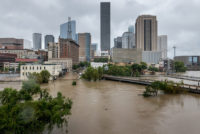As summer 2017 drew to a close, for the first time in 166 years of weather records, two Category 4 Atlantic hurricanes hit the United States in the same season—just 16 days apart. Each brought its own superlatives: Harvey, the continental U.S.’s wettest storm ever, drenched southeast Texas with as much as 51 inches of rain, while Irma maintained a devastating maximum wind speed of 185 mph over a record-setting 37-hour period. Among Texas, Florida, and the Caribbean, where both storms brutally battered small island nations before making landfall on the continent, more than 130 lives were lost, and early estimates of total damages are approaching $300 billion.
In some ways, both hurricanes proved less severe than expected. In Houston—the Harvey victim with the highest visibility—most hospitals in the Medical Center and many major cultural buildings (including the Museum of Fine Arts, Houston, which is undergoing a significant expansion by Steven Holl Architects and Lake|Flato) went largely unscathed, apart from the expected flooding of below-grade construction sites and subterranean garages. Inhabitants of residential neighborhoods built on higher ground, located in the upper reaches of watersheds, and equipped with good drainage infrastructure saw significantly less flooding, with little to no water entering buildings.
But what Harvey lacked in ferocity of winds, it made up for in sheer quantity of rain. For an agonizing five days, the storm lingered over the Texas Gulf Coast, damaging an estimated 200,000 homes and forcing many to evacuate. In Houston, water inundated two aging reservoirs built in the 1940s by the Army Corps of Engineers, filling them to the point that controlled releases, which sent a deluge to neighborhoods downstream, were required to maintain the integrity of dams. Buffalo Bayou topped its banks, submerging parts of downtown and flooding— among other buildings—the new home of the Houston AIA with more than four and a half feet of water. The architects and engineers had planned innovative flood-mitigation features for the office, but construction was incomplete when Harvey hit. (The local branch of HOK has provided temporary office space for chapter staff.) At its peak, an estimated third of Harris County, which includes Houston, was underwater.
In Florida, Hurricane Irma also played out differently from the way initial forecasts predicted. Miami avoided a direct hit, and institutions such as the Pérez Art Museum Miami, designed by Herzog & de Meuron to be hurricane resistant, “fared very well” and did not flood, a spokesperson told RECORD. Similarly, Bjarke Ingels’s new multifamily project, the Grove at Grand Bay handled the storm with success.
But high winds did their share of damage, leaving as many as 15 million state residents without power for a time. In the Keys, where destruction had not yet been fully assessed by press time, an estimated quarter of all houses were destroyed by wind and storm surge.
The aftermath of the hurricanes has raised familiar questions about land use and zoning, urbanization and sprawl, climate change and sea-level rise, and, in the architecture community, resilient design. “We’ve been preaching sustainability and resiliency for years,” says Catherine Callaway, board president of AIA Houston and senior associate at local firm Kirksey. “Now that there are new ears willing to listen, I think we have a great opportunity to talk about better ways to build and develop land.”
In Texas and Florida, once the storms dissipated, local AIA chapters quickly began to organize recovery efforts. A number of members, trained by the AIA National’s Safety Assessment Program, readied themselves to volunteer in harder-hit areas.
“I think it’s the architecture community’s responsibility to be the bellwether, to be out there at the front of the resiliency movement,” says Cheryl H. Jacobs, executive vice president of the AIA Miami chapter, which has been developing a tool kit to help municipalities make changes to zoning and land-use regulations.
Reinaldo Borges, principal of Borges + Associates Architects in Miami and chair of the local AIA chapter’s sea-level-rise task force, maintains, “You have to think the way developers think.” Whether their goals are to rent out property for the next 20 years or to sell in the next two, “You can help them make better decisions by getting into their mindset,” he says.
At Rice University, architecture professor Ron Witte, a founding partner of WW Architects, says, “Hurricanes, or other significant events that alter the chemistry of a city, help to accelerate the thinking around certain subjects.” In his view, the subject du jour in Houston is density.
“Density and staying dry go hand in hand,” says Witte, explaining that density minimizes impermeable ground and concentrates urban infrastructure, leaving cities better equipped to handle dramatic weather events, while also hastening improvements in transit, public spaces, and other social infrastructure.
“I prefer to look for the opportunity, as opposed to the doomsday story,” says Witte. “It’s far more interesting.”













Post a comment to this article
Report Abusive Comment